Jiawei Yang
BEVCon: Advancing Bird's Eye View Perception with Contrastive Learning
Aug 06, 2025Abstract:We present BEVCon, a simple yet effective contrastive learning framework designed to improve Bird's Eye View (BEV) perception in autonomous driving. BEV perception offers a top-down-view representation of the surrounding environment, making it crucial for 3D object detection, segmentation, and trajectory prediction tasks. While prior work has primarily focused on enhancing BEV encoders and task-specific heads, we address the underexplored potential of representation learning in BEV models. BEVCon introduces two contrastive learning modules: an instance feature contrast module for refining BEV features and a perspective view contrast module that enhances the image backbone. The dense contrastive learning designed on top of detection losses leads to improved feature representations across both the BEV encoder and the backbone. Extensive experiments on the nuScenes dataset demonstrate that BEVCon achieves consistent performance gains, achieving up to +2.4% mAP improvement over state-of-the-art baselines. Our results highlight the critical role of representation learning in BEV perception and offer a complementary avenue to conventional task-specific optimizations.
Occupancy Learning with Spatiotemporal Memory
Aug 06, 2025Abstract:3D occupancy becomes a promising perception representation for autonomous driving to model the surrounding environment at a fine-grained scale. However, it remains challenging to efficiently aggregate 3D occupancy over time across multiple input frames due to the high processing cost and the uncertainty and dynamics of voxels. To address this issue, we propose ST-Occ, a scene-level occupancy representation learning framework that effectively learns the spatiotemporal feature with temporal consistency. ST-Occ consists of two core designs: a spatiotemporal memory that captures comprehensive historical information and stores it efficiently through a scene-level representation and a memory attention that conditions the current occupancy representation on the spatiotemporal memory with a model of uncertainty and dynamic awareness. Our method significantly enhances the spatiotemporal representation learned for 3D occupancy prediction tasks by exploiting the temporal dependency between multi-frame inputs. Experiments show that our approach outperforms the state-of-the-art methods by a margin of 3 mIoU and reduces the temporal inconsistency by 29%.
MemOS: An Operating System for Memory-Augmented Generation (MAG) in Large Language Models
May 28, 2025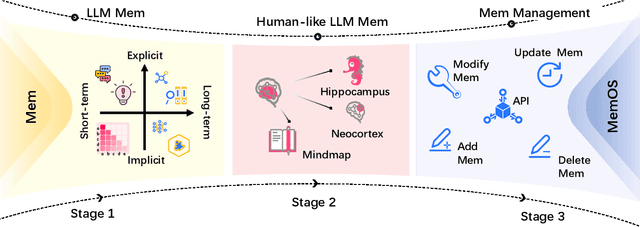
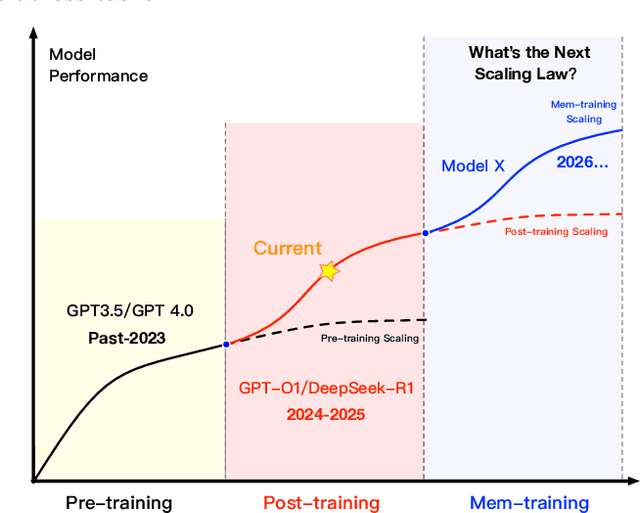
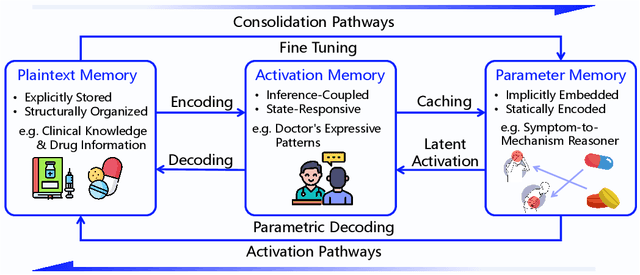
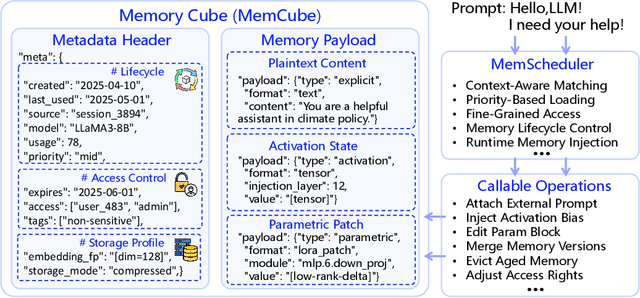
Abstract:Large Language Models (LLMs) have emerged as foundational infrastructure in the pursuit of Artificial General Intelligence (AGI). Despite their remarkable capabilities in language perception and generation, current LLMs fundamentally lack a unified and structured architecture for handling memory. They primarily rely on parametric memory (knowledge encoded in model weights) and ephemeral activation memory (context-limited runtime states). While emerging methods like Retrieval-Augmented Generation (RAG) incorporate plaintext memory, they lack lifecycle management and multi-modal integration, limiting their capacity for long-term knowledge evolution. To address this, we introduce MemOS, a memory operating system designed for LLMs that, for the first time, elevates memory to a first-class operational resource. It builds unified mechanisms for representation, organization, and governance across three core memory types: parametric, activation, and plaintext. At its core is the MemCube, a standardized memory abstraction that enables tracking, fusion, and migration of heterogeneous memory, while offering structured, traceable access across tasks and contexts. MemOS establishes a memory-centric execution framework with strong controllability, adaptability, and evolvability. It fills a critical gap in current LLM infrastructure and lays the groundwork for continual adaptation, personalized intelligence, and cross-platform coordination in next-generation intelligent systems.
SEAP: Training-free Sparse Expert Activation Pruning Unlock the Brainpower of Large Language Models
Mar 10, 2025



Abstract:Large Language Models have achieved remarkable success across various natural language processing tasks, yet their high computational cost during inference remains a major bottleneck. This paper introduces Sparse Expert Activation Pruning (SEAP), a training-free pruning method that selectively retains task-relevant parameters to reduce inference overhead. Inspired by the clustering patterns of hidden states and activations in LLMs, SEAP identifies task-specific expert activation patterns and prunes the model while preserving task performance and enhancing computational efficiency. Experimental results demonstrate that SEAP significantly reduces computational overhead while maintaining competitive accuracy. Notably, at 50% pruning, SEAP surpasses both WandA and FLAP by over 20%, and at 20% pruning, it incurs only a 2.2% performance drop compared to the dense model. These findings highlight SEAP's scalability and effectiveness, making it a promising approach for optimizing large-scale LLMs.
SampleMix: A Sample-wise Pre-training Data Mixing Strategey by Coordinating Data Quality and Diversity
Mar 03, 2025Abstract:Existing pretraining data mixing methods for large language models (LLMs) typically follow a domain-wise methodology, a top-down process that first determines domain weights and then performs uniform data sampling across each domain. However, these approaches neglect significant inter-domain overlaps and commonalities, failing to control the global diversity of the constructed training dataset. Further, uniform sampling within domains ignores fine-grained sample-specific features, potentially leading to suboptimal data distribution. To address these shortcomings, we propose a novel sample-wise data mixture approach based on a bottom-up paradigm. This method performs global cross-domain sampling by systematically evaluating the quality and diversity of each sample, thereby dynamically determining the optimal domain distribution. Comprehensive experiments across multiple downstream tasks and perplexity assessments demonstrate that SampleMix surpasses existing domain-based methods. Meanwhile, SampleMix requires 1.4x to 2.1x training steps to achieves the baselines' performance, highlighting the substantial potential of SampleMix to optimize pre-training data.
SurveyX: Academic Survey Automation via Large Language Models
Feb 20, 2025Abstract:Large Language Models (LLMs) have demonstrated exceptional comprehension capabilities and a vast knowledge base, suggesting that LLMs can serve as efficient tools for automated survey generation. However, recent research related to automated survey generation remains constrained by some critical limitations like finite context window, lack of in-depth content discussion, and absence of systematic evaluation frameworks. Inspired by human writing processes, we propose SurveyX, an efficient and organized system for automated survey generation that decomposes the survey composing process into two phases: the Preparation and Generation phases. By innovatively introducing online reference retrieval, a pre-processing method called AttributeTree, and a re-polishing process, SurveyX significantly enhances the efficacy of survey composition. Experimental evaluation results show that SurveyX outperforms existing automated survey generation systems in content quality (0.259 improvement) and citation quality (1.76 enhancement), approaching human expert performance across multiple evaluation dimensions. Examples of surveys generated by SurveyX are available on www.surveyx.cn
SafeRAG: Benchmarking Security in Retrieval-Augmented Generation of Large Language Model
Jan 28, 2025Abstract:The indexing-retrieval-generation paradigm of retrieval-augmented generation (RAG) has been highly successful in solving knowledge-intensive tasks by integrating external knowledge into large language models (LLMs). However, the incorporation of external and unverified knowledge increases the vulnerability of LLMs because attackers can perform attack tasks by manipulating knowledge. In this paper, we introduce a benchmark named SafeRAG designed to evaluate the RAG security. First, we classify attack tasks into silver noise, inter-context conflict, soft ad, and white Denial-of-Service. Next, we construct RAG security evaluation dataset (i.e., SafeRAG dataset) primarily manually for each task. We then utilize the SafeRAG dataset to simulate various attack scenarios that RAG may encounter. Experiments conducted on 14 representative RAG components demonstrate that RAG exhibits significant vulnerability to all attack tasks and even the most apparent attack task can easily bypass existing retrievers, filters, or advanced LLMs, resulting in the degradation of RAG service quality. Code is available at: https://github.com/IAAR-Shanghai/SafeRAG.
STORM: Spatio-Temporal Reconstruction Model for Large-Scale Outdoor Scenes
Dec 31, 2024



Abstract:We present STORM, a spatio-temporal reconstruction model designed for reconstructing dynamic outdoor scenes from sparse observations. Existing dynamic reconstruction methods often rely on per-scene optimization, dense observations across space and time, and strong motion supervision, resulting in lengthy optimization times, limited generalization to novel views or scenes, and degenerated quality caused by noisy pseudo-labels for dynamics. To address these challenges, STORM leverages a data-driven Transformer architecture that directly infers dynamic 3D scene representations--parameterized by 3D Gaussians and their velocities--in a single forward pass. Our key design is to aggregate 3D Gaussians from all frames using self-supervised scene flows, transforming them to the target timestep to enable complete (i.e., "amodal") reconstructions from arbitrary viewpoints at any moment in time. As an emergent property, STORM automatically captures dynamic instances and generates high-quality masks using only reconstruction losses. Extensive experiments on public datasets show that STORM achieves precise dynamic scene reconstruction, surpassing state-of-the-art per-scene optimization methods (+4.3 to 6.6 PSNR) and existing feed-forward approaches (+2.1 to 4.7 PSNR) in dynamic regions. STORM reconstructs large-scale outdoor scenes in 200ms, supports real-time rendering, and outperforms competitors in scene flow estimation, improving 3D EPE by 0.422m and Acc5 by 28.02%. Beyond reconstruction, we showcase four additional applications of our model, illustrating the potential of self-supervised learning for broader dynamic scene understanding.
InfiniCube: Unbounded and Controllable Dynamic 3D Driving Scene Generation with World-Guided Video Models
Dec 05, 2024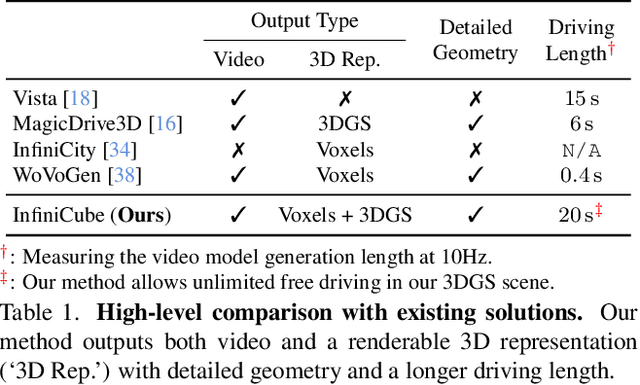
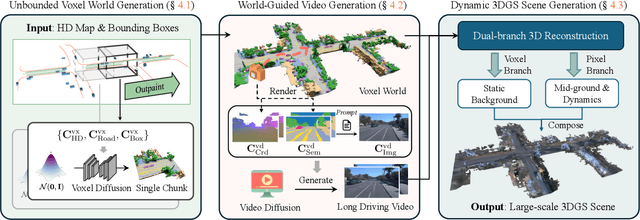

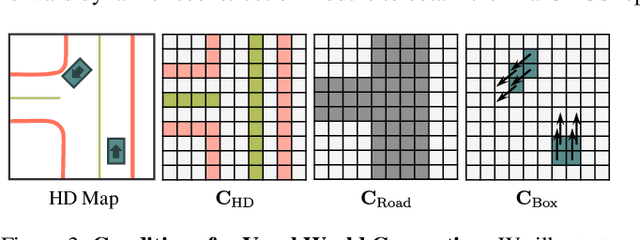
Abstract:We present InfiniCube, a scalable method for generating unbounded dynamic 3D driving scenes with high fidelity and controllability. Previous methods for scene generation either suffer from limited scales or lack geometric and appearance consistency along generated sequences. In contrast, we leverage the recent advancements in scalable 3D representation and video models to achieve large dynamic scene generation that allows flexible controls through HD maps, vehicle bounding boxes, and text descriptions. First, we construct a map-conditioned sparse-voxel-based 3D generative model to unleash its power for unbounded voxel world generation. Then, we re-purpose a video model and ground it on the voxel world through a set of carefully designed pixel-aligned guidance buffers, synthesizing a consistent appearance. Finally, we propose a fast feed-forward approach that employs both voxel and pixel branches to lift the dynamic videos to dynamic 3D Gaussians with controllable objects. Our method can generate controllable and realistic 3D driving scenes, and extensive experiments validate the effectiveness and superiority of our model.
OmniRe: Omni Urban Scene Reconstruction
Aug 29, 2024Abstract:We introduce OmniRe, a holistic approach for efficiently reconstructing high-fidelity dynamic urban scenes from on-device logs. Recent methods for modeling driving sequences using neural radiance fields or Gaussian Splatting have demonstrated the potential of reconstructing challenging dynamic scenes, but often overlook pedestrians and other non-vehicle dynamic actors, hindering a complete pipeline for dynamic urban scene reconstruction. To that end, we propose a comprehensive 3DGS framework for driving scenes, named OmniRe, that allows for accurate, full-length reconstruction of diverse dynamic objects in a driving log. OmniRe builds dynamic neural scene graphs based on Gaussian representations and constructs multiple local canonical spaces that model various dynamic actors, including vehicles, pedestrians, and cyclists, among many others. This capability is unmatched by existing methods. OmniRe allows us to holistically reconstruct different objects present in the scene, subsequently enabling the simulation of reconstructed scenarios with all actors participating in real-time (~60Hz). Extensive evaluations on the Waymo dataset show that our approach outperforms prior state-of-the-art methods quantitatively and qualitatively by a large margin. We believe our work fills a critical gap in driving reconstruction.
 Add to Chrome
Add to Chrome Add to Firefox
Add to Firefox Add to Edge
Add to Edge